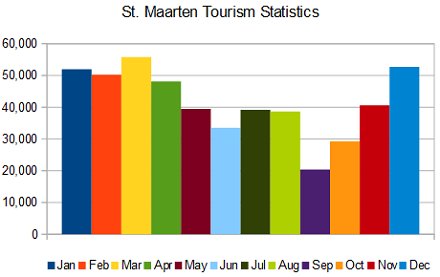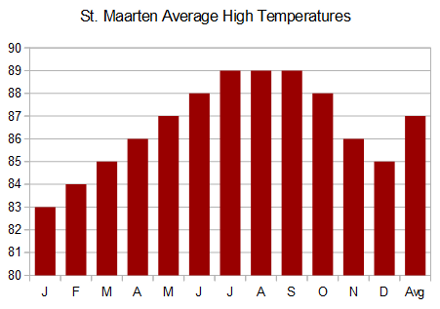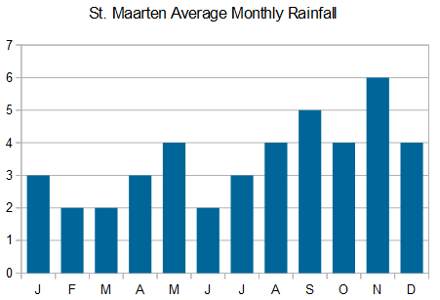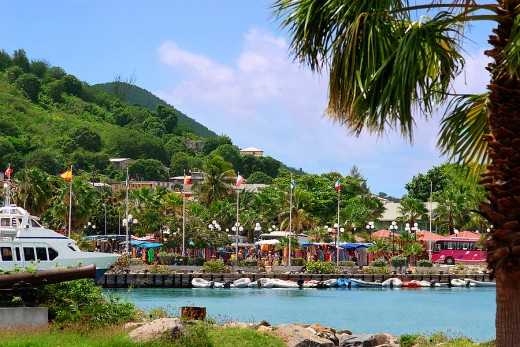Is St Maarten Going to Get Hit Again
 |
| St. Maarten has blue skies most of the year, but not September through November. © 2017 Scott S. Bateman |
The best times to visit St. Maarten are December through April when temperatures are warm and the risk of rain is low.
The worst times to visit St. Maarten are September through November when rainfall historically reaches the highest point of the year.
If there is any one month that's the best time to visit this eastern Caribbean island, it is April when rain averages 2 inches and high temperatures reach 86 Fahrenheit.
St. Maarten attracts about 2.5 million visitors every year, according to the Caribbean Tourism Organization. Out of that total, about 2 million arrive by cruise and the other half million stay for overnight vacations of up to a week or more.
Here are more tips about the best and worst times to go to St. Maarten.
- The most popular times to visit are December through April.
- The least popular months to visit are June, September and October.
- The highest average temperatures run from May through September.
- The largest amount of rain usually falls in November, followed by September.
- The best months for the lowest amount of rain are February, March and June. But June is the best month of the three for temperatures.
When is St. Maarten Hurricane Season?
The St. Maarten hurricane season officially goes from June 1 to Nov. 30 like the rest of the Caribbean. But the island feels the impact in different ways.
Historically, the island has the most rain in November even though September and October are the most active months of the Caribbean hurricane season. Despite heavy rains historically in November, hurricanes are more likely to hit or come near the island from August through October.
Hurricanes that actually hit or come near the island are rare. Instead, hurricanes pass through the region and bring heavy rains and winds. Tropical storms are more likely events.
Monthly St. Maarten Weather and Tourism
 |
| The above chart shows the number of "stayover" tourism visitors to St. Maarten in a typical year. Data source: Caribbean Tourism Organization |
January
St. Maarten weather in January reaches a low point for the year for temperatures. The average high is 83 degrees Fahrenheit or 28 degrees Celsius. The average low is 74 Fahrenheit or 23 Celsius. Rainfall averages about three inches. Tourism reaches the fourth highest level of the year.
February
Temperatures in February increase by one degree while rainfall declines to an average of two inches. Rainfall reaches the lowest point of the year. Total tourism increases slightly from January.
March
March is one of the best times to visit St. Maarten. The average high temperatures in March increase by one more degree. Rainfall stays the same as February with about two inches historically. Tourism jumps to the highest point of the year as schools go on spring break and Caribbean cruises increase.
April
Temperatures increase again by one degree. Rainfall climbs slightly to three inches. Tourism takes a big drop. Based on weather and smaller crowds, April may be one of the best months to visit the island.
May
May is a brief rainy season for many islands in the Caribbean including St. Maarten. Total historical rainfall increases to four inches. Average high temperatures climb to 87 degrees Fahrenheit or about 31 Celsius. Tourism drops to the fourth lowest month of the year.
June
June improves over May, while tourism drops again to the third lowest month. Average rainfall drops back to two inches while high temperatures increase one more degree. Like April, June has one of the best combinations of average rain, temperatures and tourism.
 |
| The average high temperatures on St. Maarten range from the low to high 80s Fahrenheit all year. © 2017 Scott S. Bateman |
July
St. Maarten weather in July usually has temperatures reaching the highest point of the year at 89 degrees Fahrenheit or 32 Celsius. Rainfall increases to three inches. Tourism increases over June.
August
August continues to the same high temperatures as July, according to historical averages. Rainfall increases to four inches as the Caribbean hurricane season becomes more active. Total tourism declines slightly.
September
September rainfall climbs to the second highest of the year and temperatures remain about the same as August. Tourism plunges to the year's lowest level as cruise lines cut back their schedules in response to the most active month of the hurricane season.
Outdoor cafes like this one in Marigot have better weather in April and July.
October
Temperatures decline by one degree in October, while rainfall drops to an average of four inches. Tourism recovers slightly, but it is still the second lowest level of the year.
November
November tourism climbs back to a level higher than May through August despite having the worst average rainfall of any month at six inches total. Tourists start to visit Caribbean islands again to escape the approaching winter.
December
Tourism jumps to the second highest month of the year. St. Maarten weather in December has an average high temperature of 85 degrees Fahrenheit or 29 degrees Celsius. Rainfall averages about four inches.
Most Popular and Least Popular Times to Go
 |
| Rainfall hits a high point in November, followed by September. © 2017 Scott S. Bateman |
December through April is a prime time for eastern Caribbean cruises that often include the Philipsburg cruise port in St. Maarten as a popular destination.
Philipsburg has one of the best cruise ports in the Caribbean because cruise visitors can walk right off the docks and onto Great Bay beach, onto the long boardwalk or just a few dozen yards in the shopping and dining district along Front Street.
The island is the smallest in the world controlled by two countries, France and the Netherlands. Cruise and hotel visitors usually stay on the Dutch side and visit the French side for its distinctive culture, beaches such as Orient Bay and excursions to nearby other islands including Anguilla, Saba and St. Barth. The many outdoor attractions depend on good weather.
Low Rainfall from December Through April
One reason for St. Maarten's popularity with visitors from December through April is that those months have some of the lowest average rainfall of the year, but temperatures also reach their low point.
Temperatures that reach into the low 80s Fahrenheit and high 20s Celsius sound attractive. But it is important to note that nighttime temperatures are cool enough to make water a bit uncomfortable for swimming, especially coupled with trade winds.
So visitors to St. Maarten in the winter and early spring should plan on land activities while lowering their expectations for swimming. Then again, they might get lucky.
Unpopular September
 |
| Marigot, St. Martin, is more festive during good weather. © 2017 Scott S. Bateman |
By far, the least popular time to go is September, which is the most active month of the hurricane season for the Caribbean. Historically, it's the second worst month of the year for St. Maarten.
The Caribbean hurricane season officially begins on June 1 and ends Nov. 30, but the region sees the most tropical cyclones (storms and hurricanes) during September and October.
The region has averaged 12 named tropical storms a year with six of them growing into hurricanes, according to the U.S. National Hurricane Center. Few of them directly hit any island such as St. Maarten because of the size of the Caribbean, but their effects can be felt hundreds of miles away.
Even though St. Maarten along with most other Caribbean destinations has the lowest number of visitors in September, the island historically receives the most rainfall in November with an average of six inches, according to the Meteorological Service of Netherland Antilles and Aruba.
September experiences an average of five inches of rain. Another four inches on average falls in May, August, October and December.
Final Recommendations
The best time to go to St. Maarten for visitors who like weather warm enough for swimming should consider going in June. The island historically experiences only two inches of rain and an average high temperature of 89 degrees Fahrenheit.
Anyone who wants to get away from cold winters up north and doesn't mind if waters are a bit cooler may consider going in March. The average high temperature is 84 degrees, and the average rainfall also is two inches.
February is the only other month of the year to average two inches of rain, which makes it another ideal time to go. The average high temperature is the lowest of the year at 83 degrees. Despite warm daytime temperatures, nighttime temperatures may make the ocean too cool for swimming for most people.
Finally, don't go from September through November, which has the highest risk of rain for the year.
There is one exception. Caribbean storms and hurricanes tend to develop in the eastern Atlantic and move west toward the Caribbean over a seven to 10-day period.
Anyone who doesn't mind a last-minute vacation can see if the forecast looks good enough to take a chance on going, especially if they can get a discounted hotel room and airline ticket at a reasonable price.
Scott S. Bateman is a professional journalist who has traveled widely throughout the Caribbean and the Americas. He is the author of four books about cruising in the Caribbean, Alaska and Mexican Riviera.
- January 06, 2022
January 06, 2022
Source: https://www.caribeez.com/st-maarten/article/best-and-worst-times-to-visit-st.-maarten
0 Response to "Is St Maarten Going to Get Hit Again"
Postar um comentário